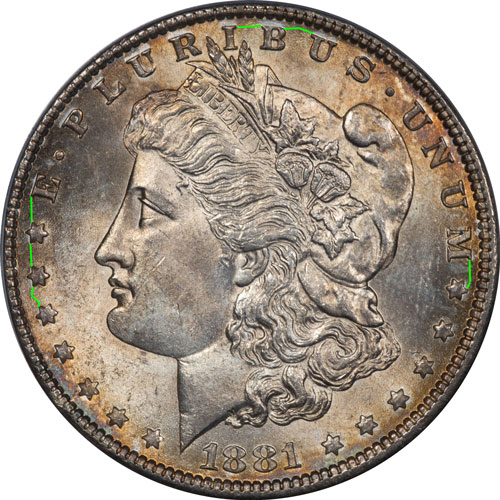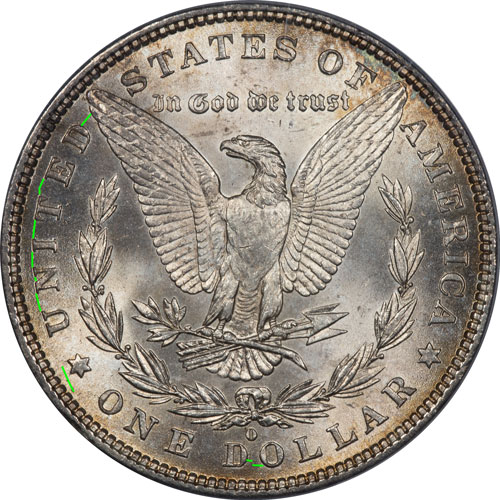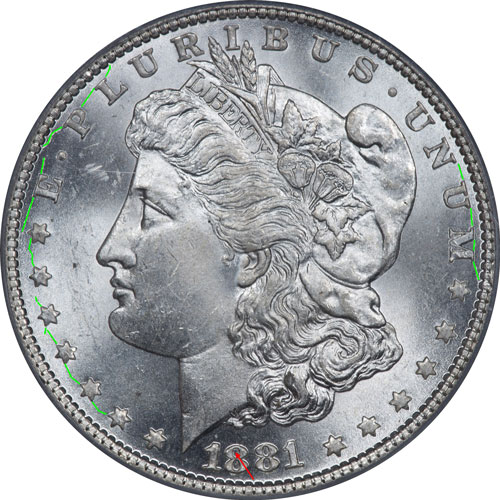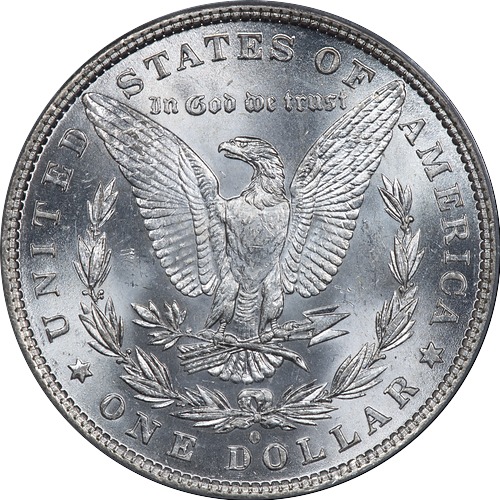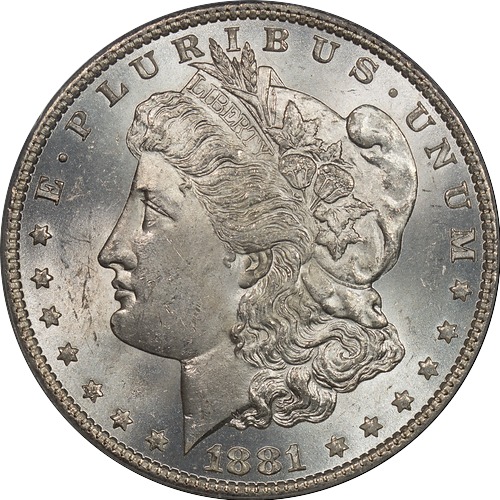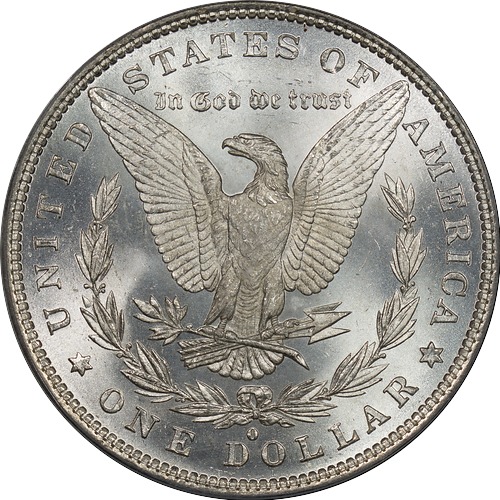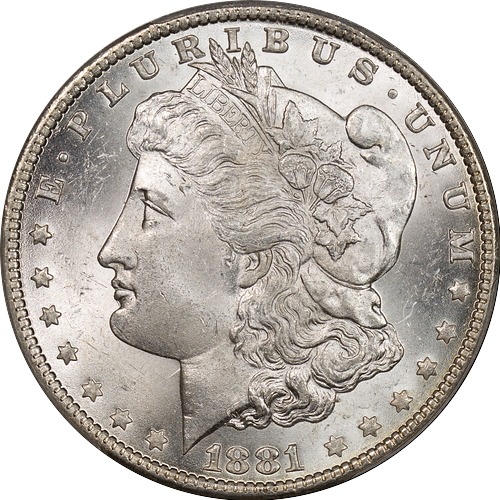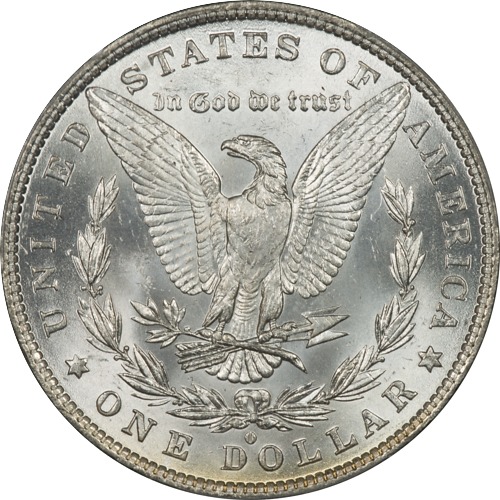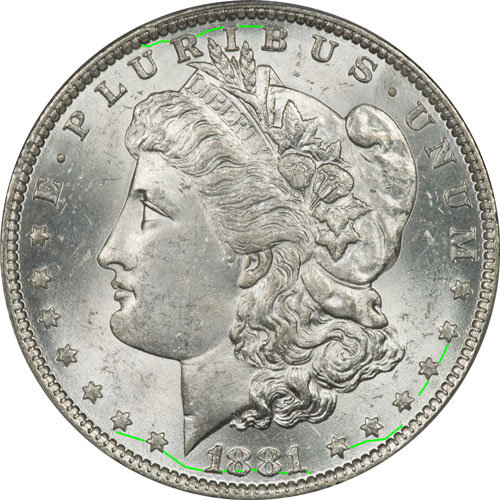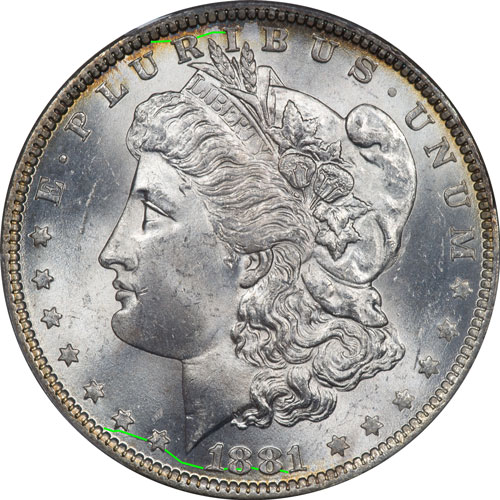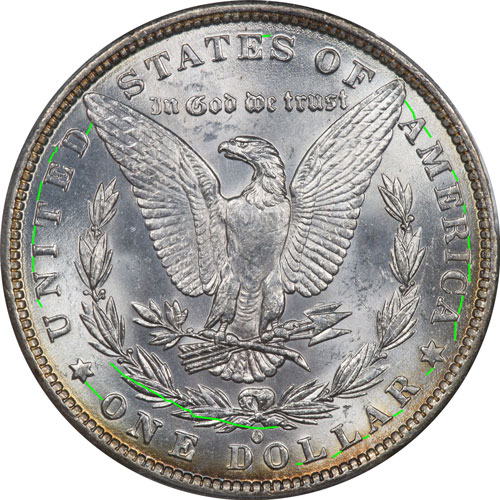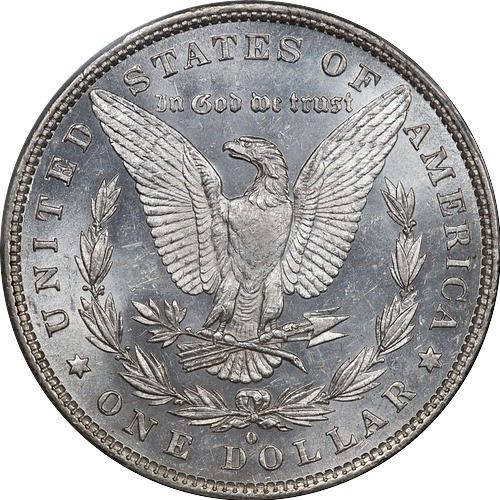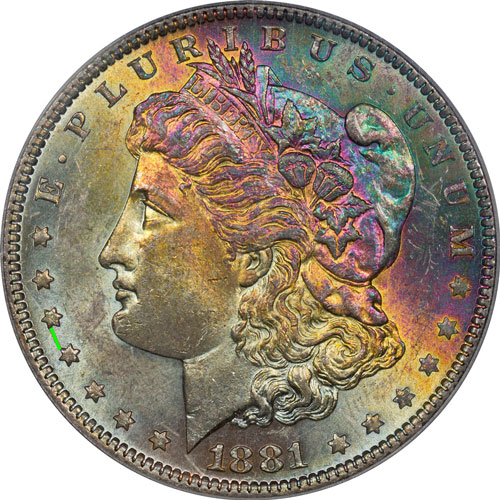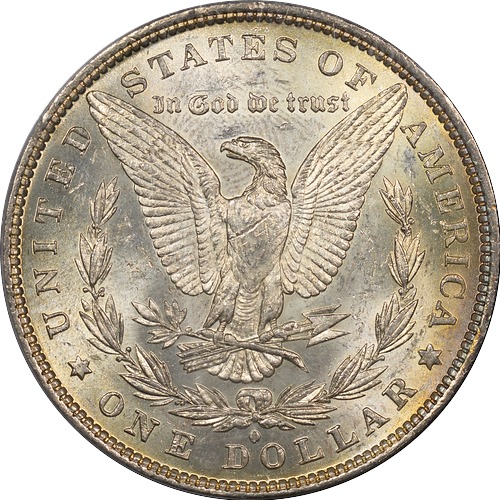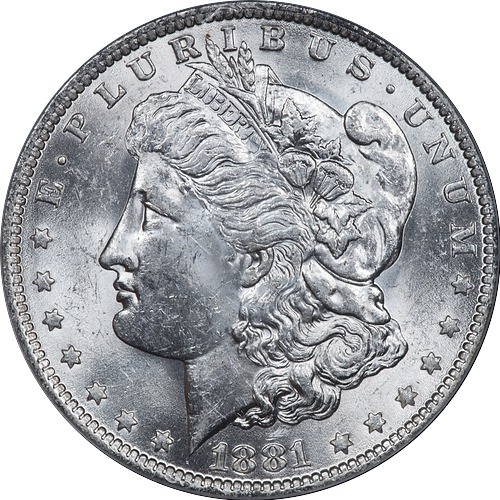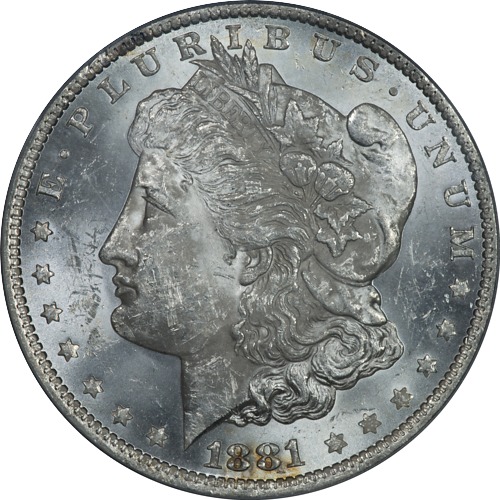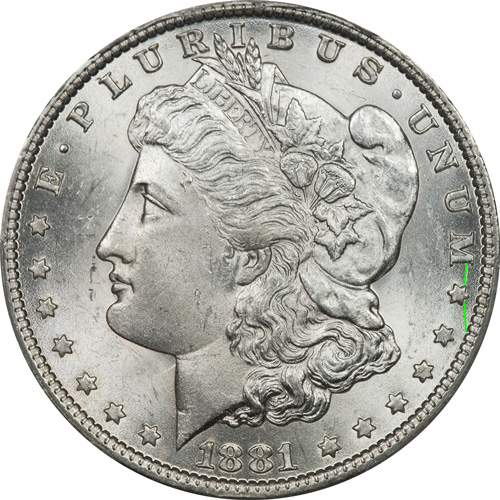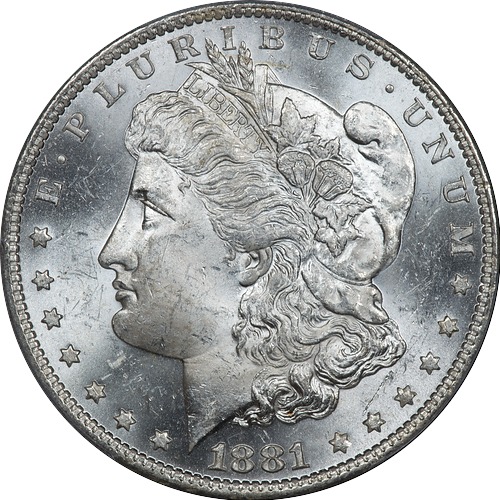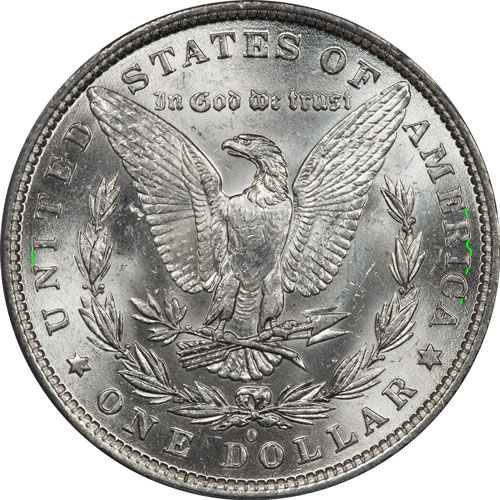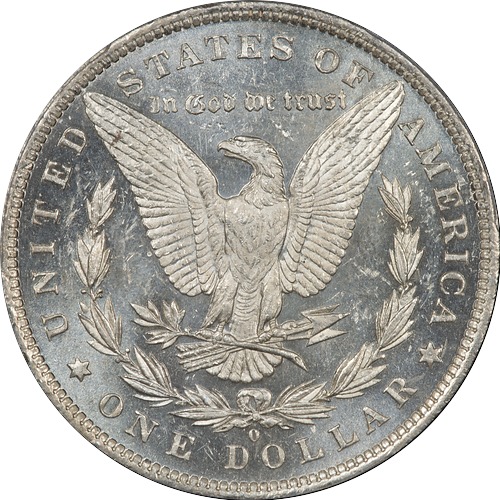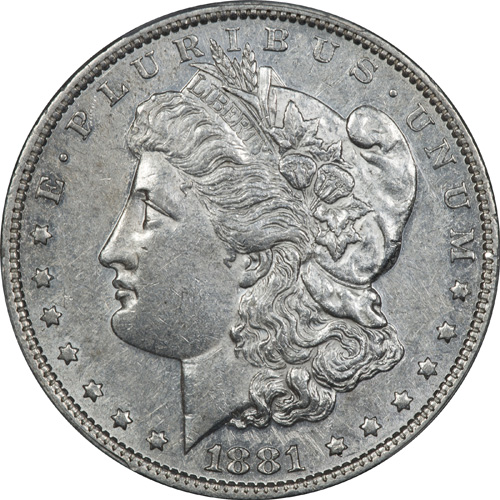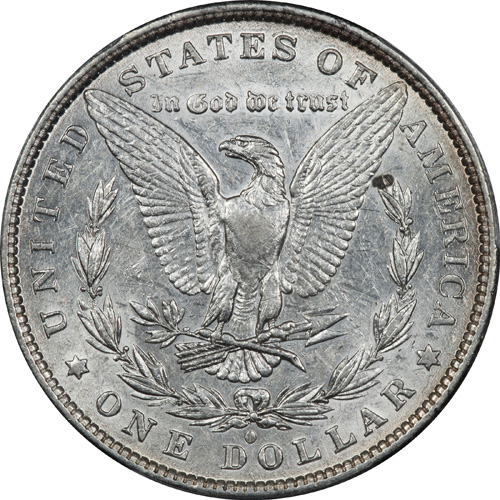
May 2019 - Welcome
Sources
Search
Contact
Home
Welcome
Click on year to expand
2022
2021
2020
2019
2018
2017
2016
2015
Welcome
Die Fingerprints
VAM's 1H and 40
![]() VSS Submissions
VSS Submissions
We continue to build toward our next submission of 20 coins but we just are not there yet. As we mentioned last month we have the coin we believe to be a VAM 47 for this next batch, so we are a little anxious to have confirmation of that find.
![]()
![]() Die Study
Die Study
The "O Set Left" study continues as you can read here. This has proven to be much more difficult than we originally thought just because of the volume of VAM's that have the l Reverse Die designation.
![]()
![]() VAM's 1H and 40
VAM's 1H and 40
There was a little discovery after closing out the April newsletter that might just keep VAM's 1H and 40 separate.
This is truly like Groundhog Day with these two VAM's. Every time we think we are done something else comes into the picture. We had put this one to bed as the same dies, and they may very well be just that. But looking back through our earlier research we found a feature on VAM's 1H and 40 that might separate them. (See the discussion in the right column)
Back in March we started an in depth discussion of the "O Set Left" series of VAMs and that work will continue this month.
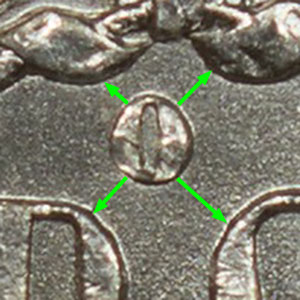
We plan just to add on to the work each month, so this page will become very long in the coming months. But this way no one has to look back at previous months to get the whole picture.
YOU CAN GO DIRECTLY TO THIS MONTH'S DISCUSSION BY CLICKING HERE.
The Missing VAMs
Now that we have a potential VAM 47 in the fold the question is "What's next?"
Well VAM 48 - O/O Lines seems attainable with some focus. So we are off in hot pursuit of that VAM. This was discovered in 2010 by an unidentified VAMer, so it is not so old as to be lost to time. But there are no large full coin images on VAMworld, so a little challenge.
![]()
If anyone has a spare let us know we would love to discuss it.
Having once again thought these two VAM's had been "put to bed" as the same, we now have discovered a feature that could separate them.
There is a lot of discussion about doubled denticles from time to time and whether you are seeing ejection marks versus true denticle doubling. We believe it is generally accepted that ejection marks always appear as a second set of denticles that are on the surface of proper denticles. We have many examples of these and they appear inconsistently at various places around the rim, but randomly.
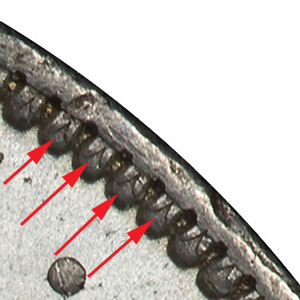
We actually have a little section on Clashed Denticles on the web site.
But when we look back at the coins that we have classified as VAM's 1H and 40 they clearly fall into two groups. One set has a few denticles behind the primary denticles, and they always appear in exactly the same place. So we would conclude that this is on the die and not part of the coining process as the ejection marks are.
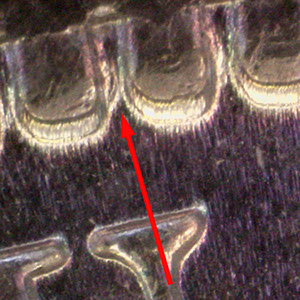
Furthermore between the two VAM's we have forty-one coins. The denticle doubling appears on thirty-three of the coins, and logically not on eight.
So the differentiation of VAM's 1H and 40 may not lie on the reverse die but on the obverse die. Wiser heads than ours will need to pass judgment on these as different enough to keep the two VAM designations or combine them into one, perhaps with a sub designation.
Morgan Dollar "Fingerprints"
Understanding the relationship between thirteen die pairs is essential to understanding the relationship and possible connections between these thirteen VAMs. This is a continuation of the discussion from February and March, and here we examine the reverse dies of ten VAMs sharing the designation of Reverse Die l (lowercase L). Three VAMs have different designations but are included because of VAMworld references or notations. They are:
- VAM 60 with a designation of Reverse Die r
- VAM 67 with a designation of Reverse Die s
- VAM 34A with a designation of Reverse Die a
We are not taking at face value that they are the same, but as with others in this discussion we are using die cracks, or failure evidence, to draw connections. As with the earlier group we are sure some will be connections can be proven and some not, but that is what this is all about.
For this analysis we have used the following inventory count:
VAM 3 - Doubled 18-1, O Set Left - 19 Coins
VAM 23 - Doubled Profile, O Set Left - 11 Coins
VAM 32 - Doubled 18-1, O Set Left - 12 Coins
VAM 34A - Doubled 18, Pinned Wing - 18 Coins
VAM 35 - Doubled 188, O Set Left - 13 Coins
VAM 35? - Possible New VAM - 1 Coin
VAM 54 - Doubled Right 1 Bottom, O Set Left - 18 Coins
VAM 56 - Doubled Right 1 Lower Right - 5 Coins
VAM-57 - Doubled Ear Right Inside, O Set Left - 3 Coins
VAM 60 - Doubled OF AMERICA, O/O Left and Set Left - 2 Coins
VAM 61 - Doubled 18, O Set Left - 13 Coins
VAM 64 - Doubled 18, Polished Forehead, O Set Left - 1 Coin
VAM 67 - Doubled 18 and Upper Reverse - 6 Coins
VAM 70 - Doubled Cap Top, UNUM, O Set Left - 2 Coins
This is obviously a large group of coins to examine, 124 to be exact, but we have some added incentive to examine this group. There are eight VAMs in this discussion (54, 56, 57, 60, 61, 64, 67, and 70) where we are the discoverer of the VAM. Validating that information takes on added importance to us.
Obverse Die 2
Reverse Die l
Obverse Die 17
Reverse Die l
Obverse Die 21
Reverse Die l
Obverse Die 23
Reverse Die a
Obverse Die 24
Reverse Die l
VAM 35? - Doubled 188, O Set Left Coin 31451530 (Potential New VAM)
Obverse Die 24
Reverse Die l?
Obverse Die 35
Reverse Die l
Obverse Die 37
Reverse Die l
Obverse Die 38
Reverse Die l
Obverse Die 1
Reverse Die r
Obverse Die 23
Reverse Die I
Obverse Die 42
Reverse Die I
Obverse Die 44
Reverse Die s
Obverse Die 47
Reverse Die l
Taking it one issue at a time (April 2019)
This is a long discussion and we have to remind ourselves that this is about reverse dies, with obverse dies used to understand pairings. This is about die cracks with other features used for confirmation. We will get into the issue of are all "O Set Left" dies the same, but that is a follow on discussion.
Of the VAMs in this discussion we can rule out VAMs 23, 32, 34A, 35, 54, 56, 57, 60, 67, and 70. In our inventory none of these coins show any signs of die cracks or breaks. We may find coins in the future that do, but for now these are not part of the discussion. We have included the VAM 35 coin we believe to be different, but not the recognized VAM 35. So we are left with a mere four VAMs to analyze and the die crack portion of this analysis begins to look much more manageable. These four are VAMs 3, 35?, 61, and 64.
Trying to draw conclusions about the similarity of these dies based on die cracks is going to be difficult at best. Of the four the only similarity we can see is between VAMs 3 and 35?, and this would be based on the die cracks in UNITED and DO. It is also difficult to visualize how the dies could have been repolished to produce these die cracks in sequence.
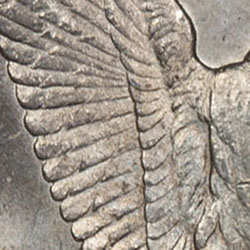
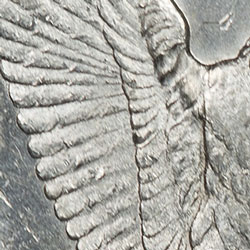
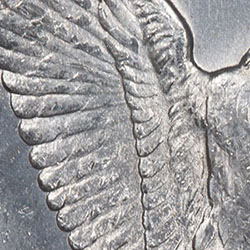
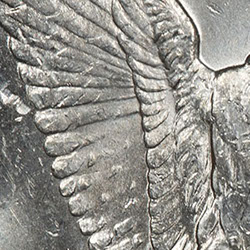
Looking at the right wing it appears that the polishing sequence would have to have been VAMs 3, 61, 35?, and 64. However, it seems unlikely that the cracks that materialized in the wreaths for VAMs 35? and 61 could have been completely repaired and not failed again in later use.
Sneaking a peek at the obverses for these four coins there is no discernible connection between them.
So where do we go from here? Well next month we will go back to the whole group and look at three characteristics that might just sort out the "O Set Left" group of VAMs. We will examine the Mint Mark, Mint Mark placement, and Wing-Neck gap.
We feel like we need to continue on with this group outside of the die crack study because of the time span over which these discoveries were identified.
VAM 3 - Doubled 18-1, O Set Left - 1965 (George Mallis)
VAM 23 - Doubled Profile, O Set Left - 1982 (Martin Field)
VAM 32 - Doubled 18-1, O Set Left - 2001 (Marc Serafine), revised 2017
VAM 34A - Doubled 18, Pinned Wing - 2010 (Rickey Bailey)
VAM 35 - Doubled 188, O Set Left - 2005 (Mike Best)
VAM 35 - Possible New VAM - ?
VAM 54 - Doubled Right 1 Bottom, O Set Left - 2015 (HawkeEye)
VAM 56 - Doubled Right 1 Lower Right - 2015 (HawkeEye)
VAM-57 - Doubled Ear Right Inside, O Set Left - 2015 (HawkeEye)
VAM 60 - Doubled OF AMERICA, O/O Left and Set Left - 2015 (HawkeEye)
VAM 61 - Doubled 18, O Set Left - 2015 (HawkeEye)
VAM 64 - Doubled 18, Polished Forehead, O Set Left - 2015 (HawkeEye)
VAM 67 - Doubled 18 and Upper Reverse - 2016 (HawkeEye)
VAM 70 - Doubled Cap Top, UNUM, O Set Left - 2016 (HawkeEye)
Fifty-one years is a significant time span and something we need to look at in more detail.
The list in the paragraph above is important because it gives us a baseline of the George Mallis discovery in 1965. If we take this as the seminal reverse die for Die l, then we have a point of comparison for the others. Before we try to group the results of the comparison based on similarities we want to first compare the other thirteen dies to this one.
We know with other VAMs that descriptions vary over time and we might have different degrees of "set left" and different slants to the mint marks. VAM 3 is also important because Mr. Mallis did not note any slant to the mint mark. It is described as "O Set Left" and in other notations described as an upright "O."
But we also need to look at other identifying features such as the wing neck gap, right wing polish, the inside of the bow, and other unique features for each VAM.
VAM 3 - Doubled 18-1, O Set Left - Die l
This becomes our baseline comparison Reverse Die l. The mint mark is 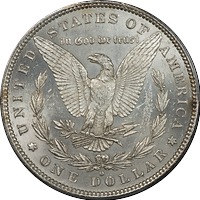 PCGS MS 6233370992VAM 3definitely set left, but remains upright. In some examples the interior of the mint mark is not clean, but also not doubled. In the left wing-neck gap there is some roughness, but more importantly there is a die gouge that runs from about 4 o'clock to 10 o'clock. This die gouge has been validated on multiple coins.
PCGS MS 6233370992VAM 3definitely set left, but remains upright. In some examples the interior of the mint mark is not clean, but also not doubled. In the left wing-neck gap there is some roughness, but more importantly there is a die gouge that runs from about 4 o'clock to 10 o'clock. This die gouge has been validated on multiple coins.
If the right wing has had any polishing it is very slight and we would not identify it as such right now. The bow has some distinct roughness that completely encircles the inside of the opening.
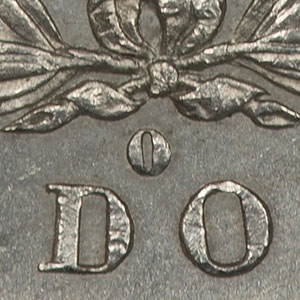
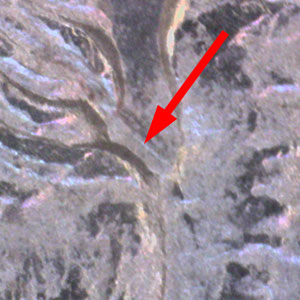
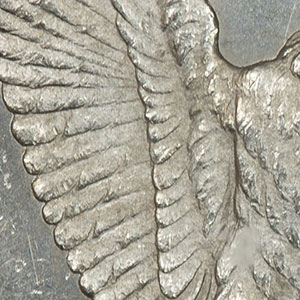
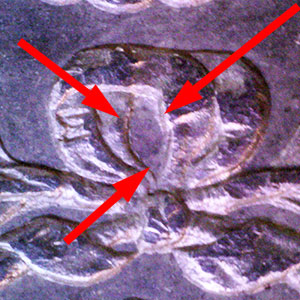
So these are going to be our four points of comparison on all the dies.
1. Upright mint mark that is set left
2. Die gouge in the left wing-neck gap
3. Very slight right wing polishing if at all
4. Roughness that encircles the interior of the bow
VAM 23 - Doubled Profile, O Set Left - Die l ?
PCGS MS 6310003913VAM 23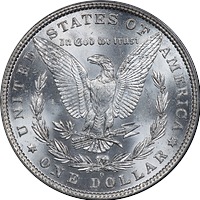 Although also designated as Die l, there was a fifteen year gap between the identification of VAMs 3 and 23. We do not believe this is the same reverse die as the baseline die on VAM 3. This die can be distinguished from the baseline die in at several different ways.
Although also designated as Die l, there was a fifteen year gap between the identification of VAMs 3 and 23. We do not believe this is the same reverse die as the baseline die on VAM 3. This die can be distinguished from the baseline die in at several different ways.
The mint mark is set left and upright as in the general description of the die, but there are major differences, some noted before and some not.
First, there is a greater degree of polish in both wings, and there are two die gouges, one on each wing, that are not present on the VAM 3, Die l coins. Second, the die gouge and roughness in the left wing-neck gap is missing, but we would concede may have been polished away.
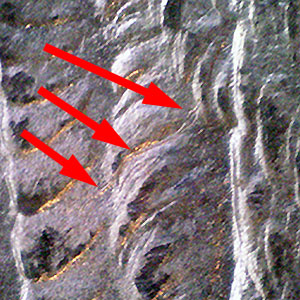
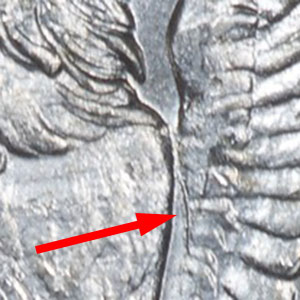
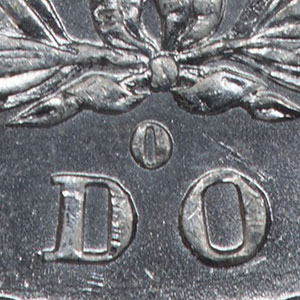
VAM 32 - Doubled 18-1, O Set Left - Die l ?
PCGS MS 6581628041VAM 32 Although also designated as Die l, there was a nineteen year gap between the identification of VAMs 23 and 32, and a thirty-six year gap between VAMs 3 and 32. We do not believe this is the same reverse die as the baseline die on VAM 3. This die can be distinguished from the baseline die in at several different ways.
Although also designated as Die l, there was a nineteen year gap between the identification of VAMs 23 and 32, and a thirty-six year gap between VAMs 3 and 32. We do not believe this is the same reverse die as the baseline die on VAM 3. This die can be distinguished from the baseline die in at several different ways.
First, the mint mark is set left, but tilted slightly right. Perhaps not as tilted as some would like but different enough from VAM 3 to be noticeable. Second, the die is pitted across the surface of the wings and in the wing-neck gap there are only some fine pitting marks. There are no die gouges on either wing or in the wing-neck gap, and the wings do not appear to have been repolished. Third, there is some roughness to the inside of the bow, but it is very different than VAM 3.
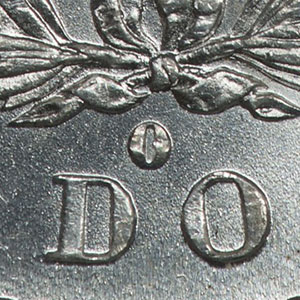
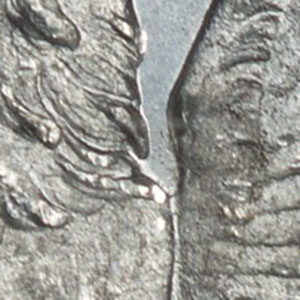
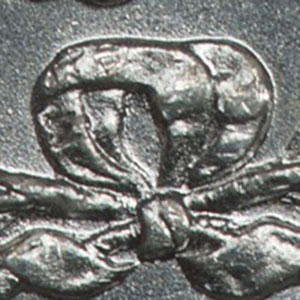
VAM 34A - Doubled 18, Pinned Wing - Die a
PCGS MS 6331774629VAM 34A VAM 34A should not be a part of this discussion except that it is an "O Set Left" variety and if there were not other prominent features the "O Set Left" just might have been a part of the discussion.
VAM 34A should not be a part of this discussion except that it is an "O Set Left" variety and if there were not other prominent features the "O Set Left" just might have been a part of the discussion.
The Reverse Die designation is a, not l and we would concur. There was a forty-five year gap between the identification of VAMs 3 and 34A, but that may have no significance. This die can be distinguished from the baseline die and others in at several different ways.
First, like VAM 32 the mint mark is set left but tilted slightly right, and to our eye slightly high. Second, the most noted item is the pinned wing which is easily identified and unique. Third, the wing-neck gap has some frostiness to it similar to VAM 3, but different. And last, any chatter in the bow is different from VAM 3.
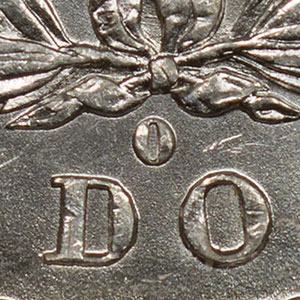
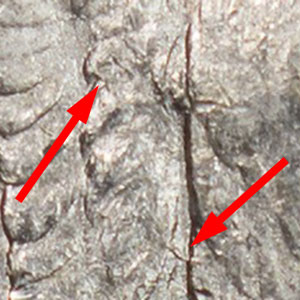
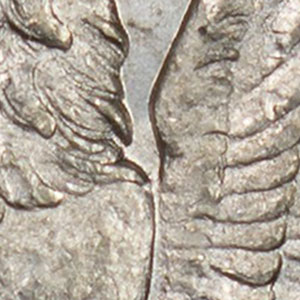
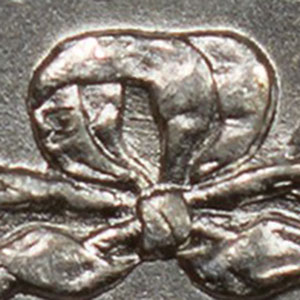
VAM 35 - Doubled 188, O Set Left - Die l
PCGS MS 6482682128VAM 35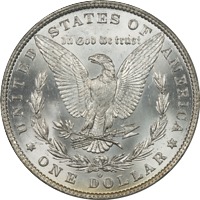 VAM 35 may in fact be two different VAMs and we will look at both of them here. The Reverse Die designation is l. This Reverse Die comes closer to being a match to the one on VAM 3 that any of the preceding VAMs. We believe that this is a later die state of Reverse Die l.
VAM 35 may in fact be two different VAMs and we will look at both of them here. The Reverse Die designation is l. This Reverse Die comes closer to being a match to the one on VAM 3 that any of the preceding VAMs. We believe that this is a later die state of Reverse Die l.
This may in fact be a later die state of the VAM 3 Reverse Die where the right wing shows heavy polishing and the chatter in the wing-neck gap and bow have been polished away. There is no pinned or gouged wing on either side and the mint mark is as close to set left and upright as we have seen.
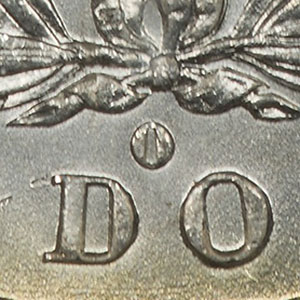
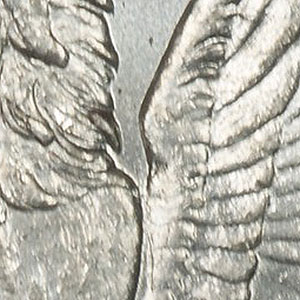
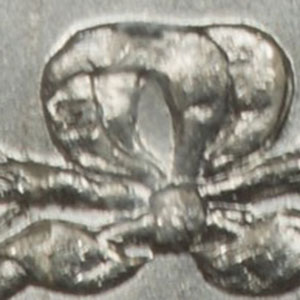
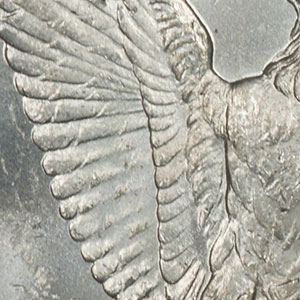
VAM 54 - Doubled Right 1 Bottom, O Set Left - Die l
PCGS MS 61DMPL14675967VAM 54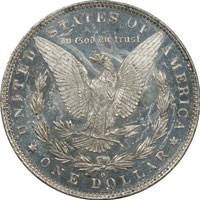 VAM 54 is one of our discovery VAMs so we can go to the Discovery Coin for verification and then validate our observations on other coins. This is not a rare VAM so there is a lot of material. Most VAM 54 coins are either DMPL or PL, but we validated these features on five MS grade coins. On most VAM 54 coins there is some white residue, often accompanied by a clear substance that clings in the crevices. We believe this to be grease or some other agent used in the coining process. The clear substance can be seen on this coin at the bottom left of the bow and the bottom of the O in DOLLAR. This is a moderately pitted die across much of the eagle which also signals die wear or misuse.
VAM 54 is one of our discovery VAMs so we can go to the Discovery Coin for verification and then validate our observations on other coins. This is not a rare VAM so there is a lot of material. Most VAM 54 coins are either DMPL or PL, but we validated these features on five MS grade coins. On most VAM 54 coins there is some white residue, often accompanied by a clear substance that clings in the crevices. We believe this to be grease or some other agent used in the coining process. The clear substance can be seen on this coin at the bottom left of the bow and the bottom of the O in DOLLAR. This is a moderately pitted die across much of the eagle which also signals die wear or misuse.
This VAM seems to be a late die state where the DMPL designation came from extensive repolishing which is visible on both wings and in the upper region of the tail feathers. The mint mark is set left and vertical, but has some polish lines inside the oval. This would not rule it out as a late die state of the reverse of VAM 3. There is some roughness in the win-neck gap, but the die gouge of VAM 3 is missing. But on a heavily repolished die this could have easily been removed. There is a different roughness to the inside of the bow, but once again nothing to rule this out as a later die state of the reverse of VAM 3. We believe that this is a later die state of Reverse Die l.

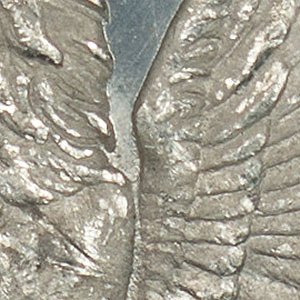
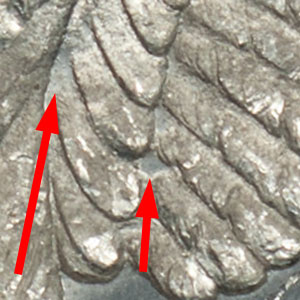
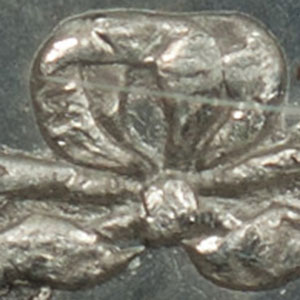
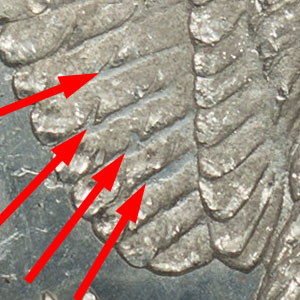
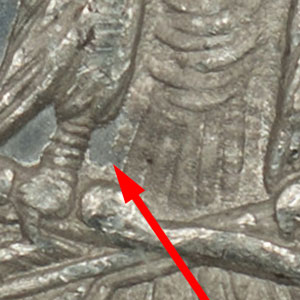
VAM 56 - Doubled Right 1 Lower Right - Die l ?
PCGS MS 6216140642VAM 56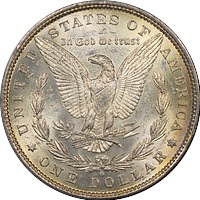 VAM 56 is one of our discovery VAMs so we can go to the Discovery Coin for observations. But this is one of those confusing coins that you need to get your microscope out and settle in to understand.
VAM 56 is one of our discovery VAMs so we can go to the Discovery Coin for observations. But this is one of those confusing coins that you need to get your microscope out and settle in to understand.
Back on VAM 3 we described a roughness on the inside of the bow that creates a unique pattern. That pattern is more evident on VAM 56 and can be illustrated as a polygon (almost). This same pattern is on the inside of the VAM 3 bow.
VAM 3 also has a small die gouge in the wing neck gap, and VAM 56 also has one. But on VAM 56 this is a different gouge. On VAM 56 it is essentially horizontal where on VAM 3 it is diagonal. That would not rule this one out as a Reverse Die i because of polishing, but it is different. If there is any polishing in the wings it is very slight.
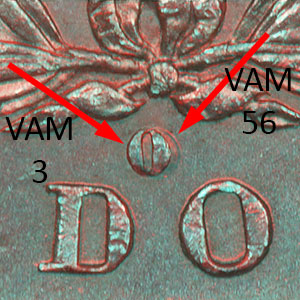 And then there is the mint mark which we think should help with the sorting out of the die. But our observation would be that this mint is not set quite as far left. So back to Photoshop to line up the two coins and we were right. The mint mark on the VAM 56 is not set as far left and is probably within the tolerance of being a centered mint mark.
And then there is the mint mark which we think should help with the sorting out of the die. But our observation would be that this mint is not set quite as far left. So back to Photoshop to line up the two coins and we were right. The mint mark on the VAM 56 is not set as far left and is probably within the tolerance of being a centered mint mark.
So this die is up in the air. It has several markings that match the Reverse Die l of VAM 3, but the mint mark is not left but centered. Unless we can find other evidence to support this as Reverse Die l, then we do not believe this is the same reverse die as the baseline die on VAM 3.

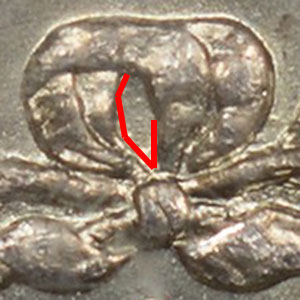
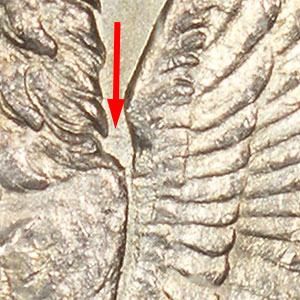
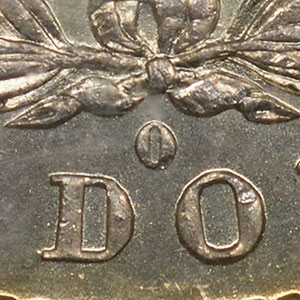
VAM-57 - Doubled Ear Right Inside, O Set Left - Die l ?
PCGS MS 6220778874VAM 57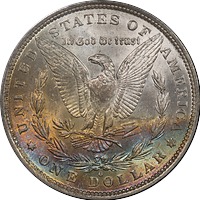 VAM 57 is another one of our discovery VAMs and is designated with a Reverse Die l. We have three examples of the VAM and all exhibit the same traits, or we probably should say the absence of traits.
VAM 57 is another one of our discovery VAMs and is designated with a Reverse Die l. We have three examples of the VAM and all exhibit the same traits, or we probably should say the absence of traits.
The wing-neck gap is completely clean and devoid of features. The interior of the bow is also clean and without features. The eagle's right wing has been polished and there is loss of detail. This leaves only the mint mark as a distinguishing feature. The mint mark is set slightly left, but also it seems to be cantered slightly left.
Based on all these factors we do not believe this is the same reverse die as the baseline die on VAM 3.
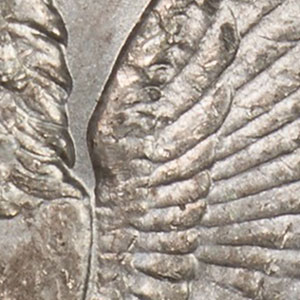
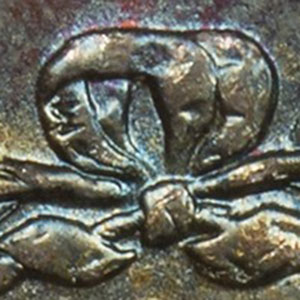
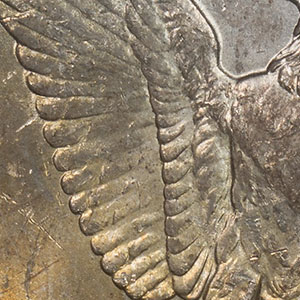
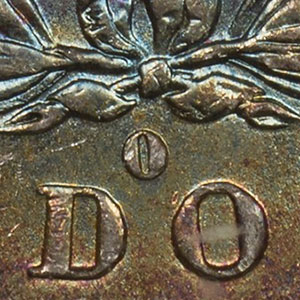
VAM 60 - Doubled OF AMERICA, O/O Left and Set Left - Die r
PCGS AU 5831588375VAM 60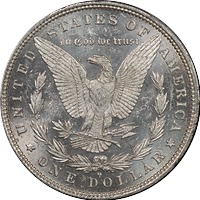 VAM 60 is another of our discovery coins from 2015 and has a different Reverse Die designation of r. We have included it here because it does have the "O Set Left" as a designated feature and we want to see if it is a re-punch of one of the other dies.
VAM 60 is another of our discovery coins from 2015 and has a different Reverse Die designation of r. We have included it here because it does have the "O Set Left" as a designated feature and we want to see if it is a re-punch of one of the other dies.
We have only two examples of VAM 60 and the discovery coin is an AU 58. But it is so lightly worn that we think it could easily have been an MS60PL or MS61PL with a different grader. We have also verified that all the features noted here are on both coins.
The first thing of note is that there are some clearly defined polishing lines in the wing-neck gap that are distinctive enough that we know they do not match any other die in this study. Also the mint mark is doubled on the inside of the O, also a distinguishing feature. It is set left, but that is the only similarity with the other dies and we can eliminate this die as a variation of the Reverse Die l.

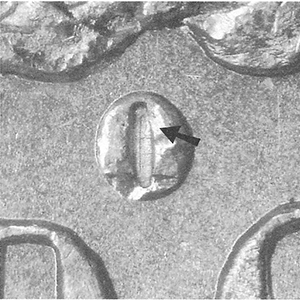
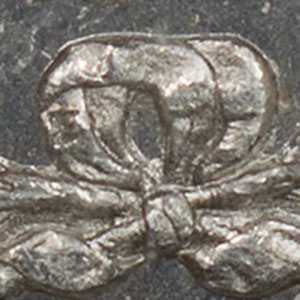
VAM 61 - Doubled 18, O Set Left - Die l ?
PCGS AU 5831698266VAM 61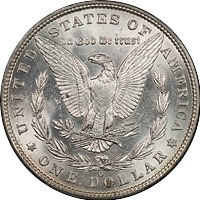 VAM 61 is one of our discoveries in 2015 and since then we have located thirteen examples, so not a rare VAM. Our discovery coin is a very lightly worn AU 58 and we have other MS coins to use to validate the features.
VAM 61 is one of our discoveries in 2015 and since then we have located thirteen examples, so not a rare VAM. Our discovery coin is a very lightly worn AU 58 and we have other MS coins to use to validate the features.
The mint mark appears to be set left and vertical. There is a distinctive die crack that runs through DOLLAR and in other areas of the die, but these do not align with other Reverse Die l coins. There is another feature with the mint mark that is a differentiating item. In the top and bottom of the mint mark there is a flat shiny area that looks similar to marks often labeled as "Dot in O." This is not that feature but it has some of the visual characteristics.
We do not believe this is the same reverse die as the baseline die on VAM 3.
This is a pitted die, but early in that failure. The pitting in the eagle's wing-neck gap does have a set pattern that can be used for identification once you have a coin for comparison.
The bow also has pitting but lacks the roughness of many of the other dies. The eagle's wings do not appear to have been repolished and also show signs of pitting.
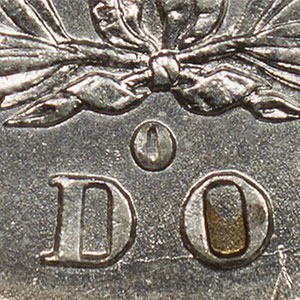
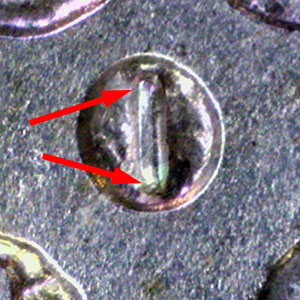
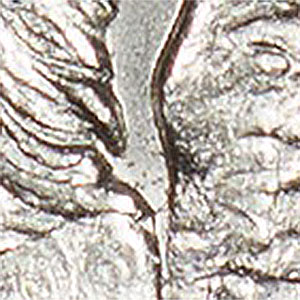
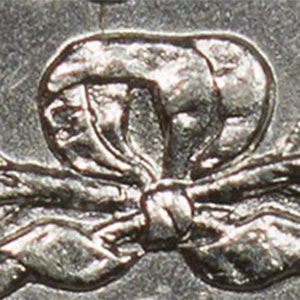
VAM 64 - Doubled 18, Polished Forehead, O Set Left - Die l
PCGS MS 6230399745VAM 64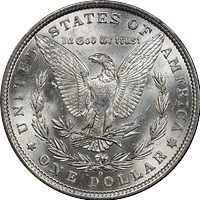 VAM 64 is a discovery of ours in 2016 and so far we have not been able to locate another example. The most distinctive feature is the polished forehead, so other features get ignored.
VAM 64 is a discovery of ours in 2016 and so far we have not been able to locate another example. The most distinctive feature is the polished forehead, so other features get ignored.
First is the eagle's wings. Both wings have been re-polished with the right wing showing more loss of detail. As one might expect with this degree of repolishing the eagle's wing-neck gap is clean (with the very faintest of pitting just beginning to show but only under a high power of magnification).
The interior of the bow has been cleaned up in this process with only the faintest of marks. We would classify the mint mark as set left and upright. The interior of the mint mark is completely clean (it is reflection in the photograph).
We believe this is the same reverse die as the baseline die on VAM 3.

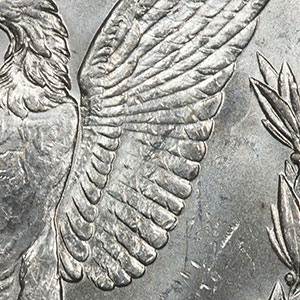
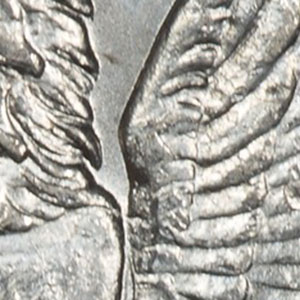
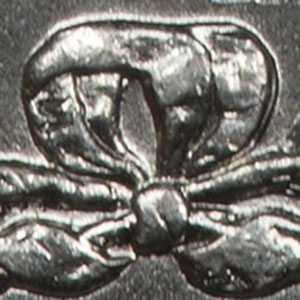
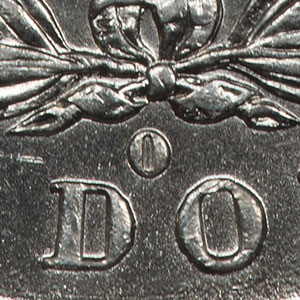
VAM 67 - Doubled 18 and Upper Reverse - Die s
PCGS MS 61 DMPL32681721VAM 67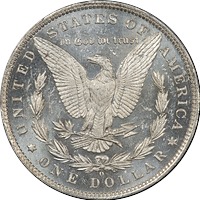 VAM 67 is a discovery of ours in 2016 and we have located six examples ranging from AU 50 to MS 62 DMPL. The discovery coin is an MS 61 DMPL, so a nice clean coin to study. Characteristics discussed here were verified on all coins.
VAM 67 is a discovery of ours in 2016 and we have located six examples ranging from AU 50 to MS 62 DMPL. The discovery coin is an MS 61 DMPL, so a nice clean coin to study. Characteristics discussed here were verified on all coins.
The mint mark is set very slightly left, but it is also tilted slightly left. If the mint mark were completely vertical we don't think this would even be considered set left and that the tilt gives it that illusion. The mint mark is completely clean on the interior.
The right wing shows only minor signs of re-polishing, but the left wing has slightly more. In our experience this is unusual since the right wing often shows signs of repolishing first. In the wing-neck gap there is a small spike that is on all coins and appears to be a small die gouge. Then there is another die gouge running through the d in God that is unique to this die. No matter how we slice it we believe this is a unique die and deserves the separate designation. We do not believe this is the same reverse die as the baseline die on VAM 3.
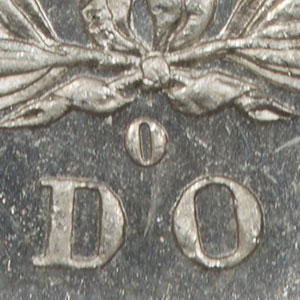
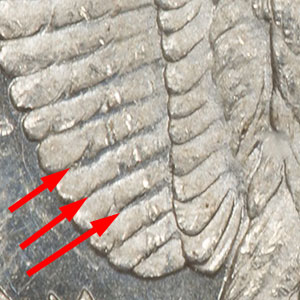

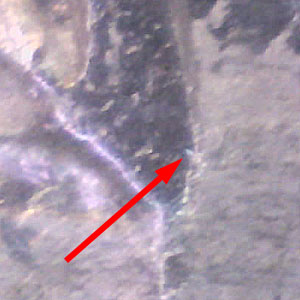
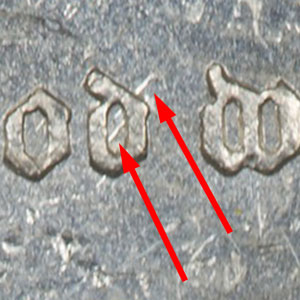
VAM 70 - Doubled Cap Top, UNUM, O Set Left - Die l
PCGS AU 5380467529VAM 70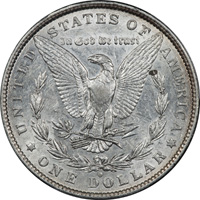 VAM 70 is also one of our discoveries in 2016 and has a Reverse Die designation of l. We have only located two examples, both of which are AU 53 coins. However, both coins show significant detail and we can reach solid conclusions from the discovery coin.
VAM 70 is also one of our discoveries in 2016 and has a Reverse Die designation of l. We have only located two examples, both of which are AU 53 coins. However, both coins show significant detail and we can reach solid conclusions from the discovery coin.
The right wing is significantly overpolished, but has no other significant traits. The mint mark is set left and vertical. The wing-neck gap is clear of any distinctions.
We believe that this is a later die state of Reverse Die l.
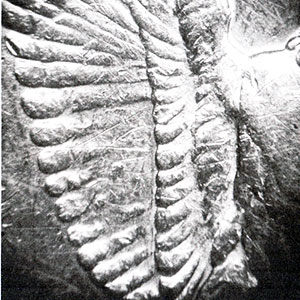
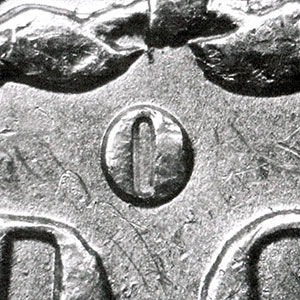

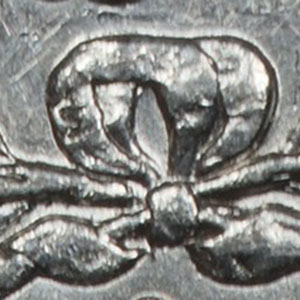
VAM 35 ? - Doubled 188, O Set Left - Die l
PCGS MS 64+31451530VAM 35?
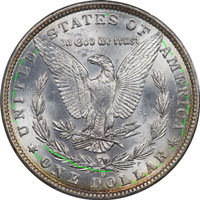 While examining all the VAM 35 coins we came across one that does not have a matching Reverse Die. We can reach this conclusion first because none of our VAM 35 coins have any die cracks while this coin has significant cracks in unique patterns. If this proves to be a new VAM then it will be our first of 2019, so we are pulling for it.
While examining all the VAM 35 coins we came across one that does not have a matching Reverse Die. We can reach this conclusion first because none of our VAM 35 coins have any die cracks while this coin has significant cracks in unique patterns. If this proves to be a new VAM then it will be our first of 2019, so we are pulling for it.
But back to our basic question concerning the similarity to the VAM 3 Reverse Die. First, the wing-neck gap has some pitting and then the area immediately below the gap and into the wing is heavily pitted.
The mint mark appears to be more centered and upright, not left and upright. At first we thought this was the reverse of VAM 1H, but the die cracks are very similar and not the same. Also on the reverse of VAM 1H the eagle's left wing is not pitted. We also compared it to a VAM 40 Reverse Die without success. The mint mark on the VAM 1H is also set slightly higher.
Unless we can find other evidence to support this as Reverse Die l, then we do not believe this is the same reverse die as the baseline die on VAM 3.
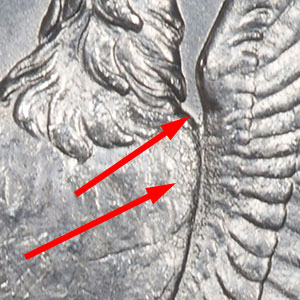
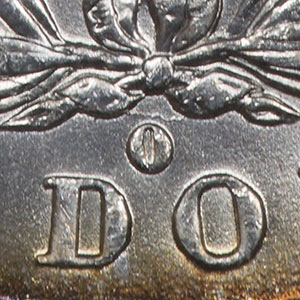
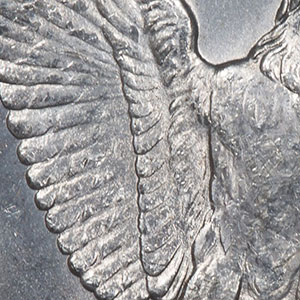
Conclusions
We started this discussion with the intention of looking first at the die cracks on all coins with the Reverse Die designation of l. Then we added to the discussion three additional coins with different die designations, but with "O Set Left" in the title or official description of the die. Then along the way we discovered what we think is another discovery die while examining VAM 35.
The gave a total examination pool of fourteen VAMs and 124 coins. Looking at all these has produced some validation, some surprises, but also some unanswered questions. Below are the conclusions we have reached from the details above.
- We have to have a seminal Reverse Die l to use for comparison and the most logical is VAM 3, which was identified back in 1965 by George Mallis. While it was fifty-four years ago, it is the most logical die to use for baseline comparison for the Reverse Die l coins that followed.
- The three VAMs with "O Set Left" in their description, but not designated as Reverse Die l, are in fact different and they do not appear to match with any of the Reverse Die l coins. These include VAMs 34A, 60, and 67.
- Of the remaining eleven VAMs studied, five seem to match to the seminal VAM 3. These include VAMs 3, 35, 54, 64, and 70.
-
Six of the Reverse Dies do not match the characteristics of VAM 3, Reverse Die l. These include 23, 32, 56, 57, 61 and the potential odd ball 35.
- The VAM 23 reverse die has the upright "O Shifted Left", but it also has two unique die gouges that cannot be tied to any other die.
- The VAM 32 reverse die has an "O Shifted Left" but tilted right and not upright.
- The VAM 56 reverse die has an "O" that is not shifted far enough left and tilted very slightly right. Also there is a unique die gouge in the wing-neck gap.
- The VAM 57 reverse die has an "O Shifted Left" but it is not upright and is tilted left. It is also devoid of features in the wing-neck gap, bow, and wings that might tie it back to the Reverse Die l.
- The VAM 61 reverse die has two unique flat spots at the top and bottom of the inside of the mint mark that are unique.
- The potential new VAM from the VAM 35 group has some unique pitting in the wing-neck gap and on into the wing. There is some extensive die cracking on the die that we may match to another existing die, but so far that has eluded us. Even if we do locate a die match we will have a new pairing we think.
Getting Started
Collecting The 1881-O
The 1881-O VAMs





















